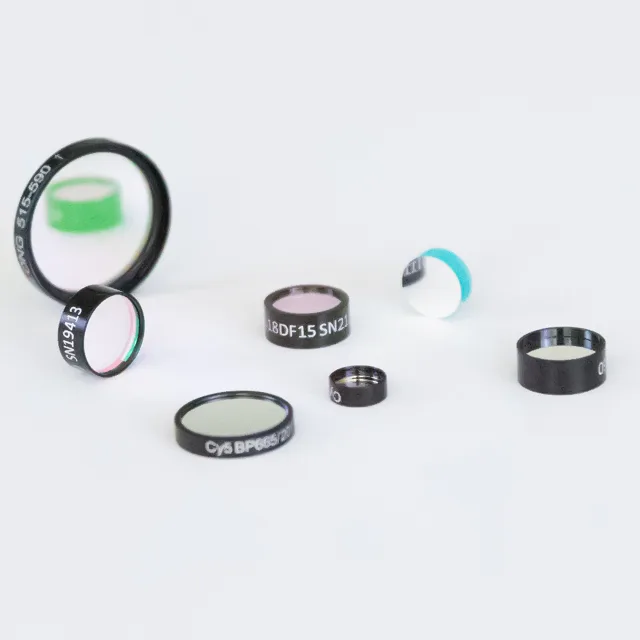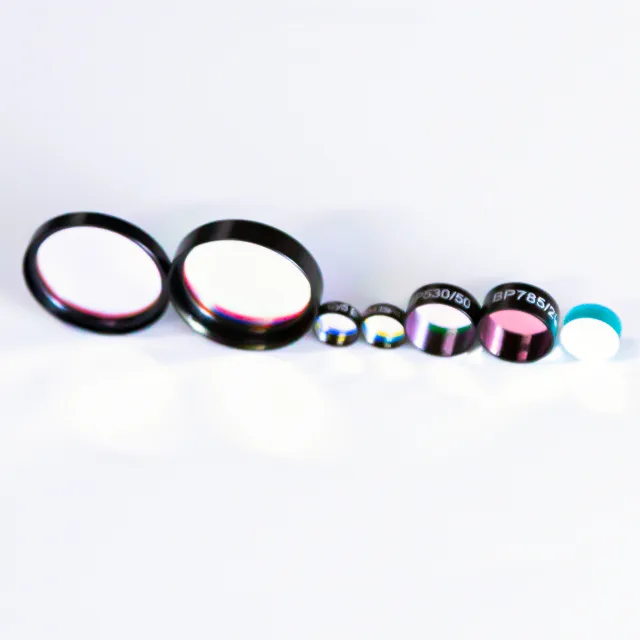In the realm of optical technology, Dichroic Mirrors play a pivotal role in manipulating light for various applications.
These specialized mirrors operate on the principle of thin-film interference, where the interference of light waves leads to selective reflection or transmission based on their wavelengths.
This unique property enables Dichroic Mirrors to separate light into different colors, making them indispensable in fields such as spectroscopy, fluorescence microscopy, and projection systems.
Conventional filters, on the other hand, function primarily through an absorption or reflection mechanism, selectively allowing light of a particular wavelength to pass through while blocking light of other wavelengths.
This approach usually relies on materials that absorb specific wavelengths to achieve selective transmission of a portion of the spectrum.
Dichroic mirrors, through their reflection and transmission mechanisms, are particularly important in specific high-end optical applications such as projectors and fluorescence microscopes.
Dichroic mirrors demonstrate flexibility and versatility by being able to precisely separate and combine light rays simultaneously in the same optical path. This capability highlights the unique value and application potential of dichroic mirrors in optics.
Understanding How Dichroic Mirrors Work
The Science Behind Dichroic Mirrors

Dichroic mirrors operate on a fascinating principle known as thin-film interference. This phenomenon occurs when light waves reflect off the multiple layers of thin films that compose the mirror.
As a result, certain wavelengths of light interfere constructively, leading to their selective reflection, while others interfere destructively and are consequently transmitted through the mirror.
This intricate process allows dichroic mirrors to effectively separate incoming light into its constituent colors, enabling precise control over the spectral composition.
Another crucial factor in the functionality of dichroic mirrors is the refractive indices of the materials used in their construction. These indices determine how much light is bent or refracted as it passes through each layer of the mirror.
By carefully selecting materials with specific refractive indices, dichroic mirrors can achieve optimal color separation and transmission efficiency.
Advantages of Using Dichroic Mirrors
The utilization of dichroic mirrors offers several distinct advantages in various optical applications:
Precision in Wavelength Selection
Dichroic mirrors excel in selectively reflecting or transmitting specific wavelengths with remarkable accuracy.
This precision is invaluable in fields such as spectroscopy and fluorescence microscopy, where isolating individual wavelengths is essential for detailed analysis and imaging.
Durability and Efficiency
Due to their construction using durable thin-film coatings, dichroic mirrors exhibit exceptional durability and efficiency in manipulating light.
Their ability to withstand prolonged exposure to intense light sources makes them ideal for long-term use in demanding optical systems.
Exploring the Functionality of Traditional Filters
Working Principles of Traditional Filters
Traditional filters rely on distinct working principles compared to dichroic mirrors, primarily utilizing either absorption or reflection to achieve selective light transmission. In absorption-based filters, specific materials are employed to absorb unwanted wavelengths, allowing only the desired portion of the spectrum to pass through.
On the other hand, reflection-based filters operate by reflecting certain wavelengths while permitting others to transmit through the filter. These mechanisms enable traditional filters to effectively control the spectral composition of light for various applications.
Material composition plays a pivotal role in determining the filtering capabilities of traditional filters. The choice of materials directly impacts the filter’s ability to selectively transmit or block specific wavelengths.
By carefully selecting and engineering materials with tailored optical properties, traditional filters can achieve precise control over light transmission, catering to diverse requirements across different industries.
Benefits and Limitations
Traditional filters offer notable advantages alongside inherent limitations:
Cost-Effectiveness and Versatility
One key advantage of traditional filters lies in their cost-effectiveness and versatility. They are often more economically viable for widespread use in applications such as photography, where precise color manipulation is essential. Additionally, their versatile nature allows for seamless integration into various optical systems and devices.
Limitations in Precision and Durability
Despite their versatility, traditional filters face limitations in terms of precision and durability when compared to dichroic mirrors.
The reliance on absorption or reflection mechanisms may result in less precise control over wavelength selection, impacting their suitability for highly specialized optical applications.
Furthermore, their durability may be compromised under prolonged exposure to intense light sources, requiring frequent replacement or maintenance.
Comparative Analysis: Dichroic Mirrors and Traditional Filters
1. Performance Comparison
When comparing the performance of Dichroic Mirrors and traditional filters, one crucial aspect to consider is their wavelength accuracy and efficiency. Dichroic Mirrors exhibit exceptional precision in separating and manipulating specific wavelengths of light, making them highly efficient for applications requiring precise spectral control.
In contrast, traditional filters may offer versatility but often lack the same level of accuracy in isolating individual wavelengths.
Moreover, the longevity and maintenance needs of both technologies differ significantly. Dichroic Mirrors, with their durable thin-film coatings, are known for their longevity and minimal maintenance requirements.
Their ability to withstand prolonged exposure to intense light sources contributes to their extended lifespan.
On the other hand, traditional filters may require more frequent replacement or maintenance due to their reliance on absorption or reflection mechanisms, which can degrade over time.
2. Cost Analysis
In terms of cost analysis, the initial investment required for Dichroic Mirrors may be higher than that for traditional filters. However, this upfront cost is often justified by the long-term savings associated with the durability and efficiency of dichroic technology.
Conversely, while traditional filters may have a lower initial investment, their ongoing maintenance and replacement costs should be factored into the overall cost analysis.
Additionally, considering application-specific cost considerations is essential when evaluating these optical technologies. The suitability of each option for different applications depends not only on their initial cost but also on factors such as long-term maintenance needs and the specific requirements of the intended use case.
3. Suitability for Different Applications
Determining when to choose Dichroic Mirrors or opt for traditional filters depends on the unique demands of each application.
Dichroic Mirrors are ideal for applications that demand unparalleled wavelength precision and efficiency, such as advanced spectroscopy and fluorescence microscopy.
Conversely, situations favoring traditional filters include scenarios where cost-effectiveness and versatile light manipulation are prioritized over absolute precision.
Applications in Various Fields
1. Dichroic Mirrors in Advanced Technologies

Dichroic mirrors find extensive applications in cutting-edge laser systems and various optical devices. Their ability to precisely separate and manipulate light based on wavelengths is crucial in enhancing the performance and efficiency of laser technologies.
In optical devices, dichroic mirrors contribute to the development of advanced imaging systems and optical communication tools, where the selective transmission of specific wavelengths is essential for optimal functionality.
Moreover, Dichroic Mirrors play a pivotal role in medical and scientific research, particularly in fields such as fluorescence imaging and spectroscopy. In medical settings, these mirrors enable the precise isolation of specific wavelengths for diagnostic imaging and therapeutic procedures.
In scientific research, they facilitate detailed analysis of molecular structures and interactions through fluorescence microscopy, contributing to advancements in various scientific disciplines.
Click to learn: Dichroic Mirror: What is It? Advantages and Applications
2. Traditional Filters in Everyday Use
In everyday scenarios, traditional filters are widely employed in photography and lighting applications to achieve desired color effects and control light intensity.
Photographers utilize traditional filters to enhance or modify the colors captured in their images, adding artistic flair or compensating for different lighting conditions.
Additionally, traditional filters play a crucial role in controlling light dispersion and intensity in various lighting setups, catering to diverse aesthetic and functional requirements.
Furthermore, traditional filters are integral to industrial and environmental monitoring, where precise control over light transmission is essential for accurate measurements and observations.
In industrial settings, these filters aid in monitoring processes that rely on light-based sensors or visual inspections. Similarly, environmental monitoring instruments utilize traditional filters to analyze ambient light for assessing air quality, pollution levels, and ecological parameters.
Conclusion
As the comparative analysis between dichroic mirrors and traditional filters unfolds, it becomes evident that the choice between these optical technologies hinges on specific application requirements.
Dichroic Mirrors stand out for their unparalleled precision in wavelength selection and longevity, making them ideal for advanced spectroscopy and fluorescence microscopy. On the other hand, traditional filters offer cost-effectiveness and versatility, catering to everyday applications in photography and lighting.
1. Making the Right Choice for Your Needs
When considering optical filtering technologies, it is crucial to assess the unique demands of each application. For scenarios necessitating precise spectral control and durability, Dichroic Mirrors emerge as the optimal choice.
Conversely, when cost-effectiveness and versatile light manipulation are prioritized over absolute precision, traditional filters prove to be a practical solution.
2. The Future of Optical Filtering Technologies
Looking ahead, advancements in material science and optical engineering are poised to drive innovation in both dichroic mirrors and traditional filters.
The integration of novel materials with tailored optical properties holds promise for enhancing the performance and versatility of these technologies across diverse applications.
As research continues to push boundaries, the future landscape of optical filtering technologies is set to witness further refinement and expanded capabilities.
In conclusion, understanding the distinct advantages and limitations of dichroic mirrors and traditional filters empowers decision-makers to make informed choices aligned with their specific needs and objectives.
Click to learn more about Optolong’s dichroic mirrors and make a wise choice for your project.
